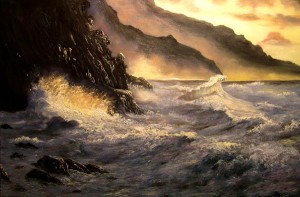How to Paint Fog?
Posted by admin | Under General, Oil Painting Saturday Apr 24, 2010 In the early spring, if you take your sketch pad to one of the off-shore islands along the coast of Maine, there is one thing you will come to know and to live with fog. When the visibility drops below a mile or so, you can be sure the foghorn will start pumping its low, mournful blast with a prearranged pattern. By checking this pattern on their charts, the vessels approaching the island will know exactly what landfall they have made. They may slowly pick their way into the harbor and layover until it clears, or they may pass by, never seeing the land where the friendly warning sounds of the horn emanated. A newcomer to the island may find this sound and vibration disturbing at first, may even have a sleepless night, but soon the mind accepts the rhythm of the horn and no longer consciously hears it.
In the early spring, if you take your sketch pad to one of the off-shore islands along the coast of Maine, there is one thing you will come to know and to live with fog. When the visibility drops below a mile or so, you can be sure the foghorn will start pumping its low, mournful blast with a prearranged pattern. By checking this pattern on their charts, the vessels approaching the island will know exactly what landfall they have made. They may slowly pick their way into the harbor and layover until it clears, or they may pass by, never seeing the land where the friendly warning sounds of the horn emanated. A newcomer to the island may find this sound and vibration disturbing at first, may even have a sleepless night, but soon the mind accepts the rhythm of the horn and no longer consciously hears it.
In the springtime along the coast of New England (and England too), one can expect all types of weather to occur in a short span of time-rain, snow, cold, warmth, sun and fog. If the artist loves change, this is the time and place for it. This is the time, too, when the heavy oceans and fog combine to give the artist a quality of mystery and composition that is both strong and yet can be very subtle-a wonderful time to study shapes and reflections and the unexpected.
I recall one time when the breeze held in the west for two days with a clear sunny zenith and rather cool spring weather. Then a change took place. The weather vane made its slow, unseen swing to the southeast, bringing with it warmer southern air on a collision course with the cold North Atlantic. With this set of conditions, only one thing could occur: fog. And occur it did, accompanied by strong winds and heavy oceans. All during the night one could hear the low rumble of the surf on the far side of the island, muffled by the heavy moisture content of the air. The unpredictable North Atlantic was doing her best to stifle both sound and sight. The lighthouse beacon could no longer be seen and the sound of the foghorn was carried away from the island towards the mainland. By morning, it was very thick.
It took only a few steps from my studio to be engulfed in the heavy greyviolet fog. It is but a quarter of a mile from my studio to the easterly side of the island yet, in that short distance, I experienced the full range of color changes that occur in the spectrum. In the low flatlands near my studio, the fog lay at its heaviest, reducing the amount of light that could pass through it from the sun in zenith, so that it tended towards violet-grey.
As I walked up the hill towards the lighthouse, the wind shifted the fog into varying thicknesses. Sometimes the blue of the overhead sky made its presence felt. Other times, the mixture of warm sun and blue sky produced grey-green. Looking towards the place where the sun should be, I saw its influence showing through the fog at times with a pale orange and yellowgrey. These colors could only be seen in relation to one another, they are so subtle.
It may seem strange to relate this fog to a sunset or a moonlight or any other type of picture. But as far as the spectrum is concerned, they are the same, just presented to us in a different visual manner. One of the few things you can rely on is the spectrum, and knowledge of it will allow any artist to see deeper into the emotional side of painting.
Beyond the lighthouse I passed through a spruce forest that led to the inlets. Here the fog was being gathered up by the rich green needles of the trees and producing its own rainfall for the roots below. On the trip to the far side of the island, I could have paused at any number of places to sketch, for the fog had created countless compositions for an artist to contemplate and paint-the mysterious shapes of people and buildings drifting in and out of the fog, the half-seen boats at the dock, the fish houses emerging for just one moment, the grasses III the meadow around the lighthouse still dressed in their golden brown of winter, the quiet spruce forest wearing its mantle of permanent green.
But the ocean and rocks are what I was headed for. You can hear the ocean crashing below you as you emerge on a headland, but it is not to be seen. It is engulfed in nature’s cauldron of swirling fog 200 feet below. The path down the side of the headland is steep but short, ending on great blue-black rocks below, that reflect their wet surfaces as though all had been freshly varnished. The highlights stand out like jewels against the velvet background of the rich dark rocks. On a day such as this, I could see very clearly each individual color in the foreground-the grey colors that come from dryness are gone; the brilliant sun that makes you squint, reducing color, is not present; the dim light of nighttime or a storm does not impede your vision. Strangely enough, the immediate foreground of a painting on a foggy day can be your richest in color. On a bright sunlit day, you hardly notice the periwinkles, the rockweed, the kelp in among the rocks, but on a day such as this, each stands out, revealing its colors. As soon as your vision travels from the foreground to the distance, these easily seen things disappear in the fog, creating a strong rich foreground against the pale light background.
The ocean on this day was evasive, sometimes seen, other times disappearing into thicker fog. A cresting wave built up and crashed somewhere in the fog, its pale greys and greens undulating in slow motion. I had to wait before seeing it cascading in from the nothingness, swirling among the dark rocks with its white foam, creating great contrasts in the foreground. It was cold and I was wet, but the sight was inspiring. My sketches show large dark shapes of the foreground arranged in strong patterns against the background. The flat rocks I stood on slipped towards the ocean with the Converging lines helping to lend depth to the foreground, the dark upright planes of the outcropping rocks reflecting across the wet surfaces of the foreground. If there IS anyone thing this picture will demand, it is the feeling that everything is receiving a complete soaking and that nothing is escaping it. The use of one object reflecting upon another and the foggy sky reflecting on the whole picture must be ·an integral part of this painting.
The palette for the painting of “Fog” was Prussian blue, yellow ochre, raw sienna, burnt sienna, Venetian red and Mars violet. Zinc white was selected for its property of staying wet for an extended period of time, allowing me to work wet-in-wet until the picture was completed. A small amount of poppy oil was added to the white paint with a spatula to slow the drying time even more. Prussian blue was selected because it tends to the green of the spectrum. It is very dark and rich and when mixed with the above earth colors (except Mars violet) produces varying shades of greys and grey greens. Mars violet, when mixed with Prussian blue gives the artist a soft grey and grey-violet.
There is a lonely, intimate feeling as you stand alone in the heavy fog, watching the half-seen ocean with the slippery, wet rocks beneath your feet. I felt in the painting of the picture “Fog” that I should keep my foreground rather fiat, with a few, large upright planes of massive rocks outcropping. The rocks would provide me with the necessary dark reflections, to create a wet feeling in the foreground. I selected my vantage point close to the ocean, in among the rocks to give full impetus to the wetness and intimacy of the composition.
The washing in of my canvas was basically one large area of light grey sky against the dark grey rock patterns of the foreground. Further development of the painting would see the introduction of half-lights and half-tones for the emergence of the wave in the middle distance. The edges of the wave and its surrounding water should be kept soft so as to half-lose these forms into the sky and fog.
The foreground rocks should be held dark and rich in color, the upright rocks reflecting their color and tones across the flat rock surfaces. The sky colors and values should make their presence felt on the flat wet surfaces where the upright rocks are not reflecting. In this manner, dark passages meet light, and a feeling of wetness may be achieved. The very subtle modeling of the dark, foreground rocks slowly merging with the lighter, middle distant rocks and then disappearing into the fog-this was of paramount importance to convey to the observer my impression of that wet, spring day on an offshore island in Maine.
